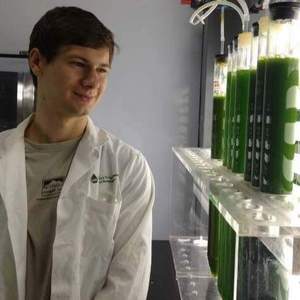Arizona State University student creates algae-inspired art

Photo: ASU LightWorks
June 4, 2013
BY ASU LightWorks
Making what’s commonly referred to as “green slime” artistic may seem like a herculean feat, but Arizona State University student Phillip Carrier is using the tiny plants as inspiration for an art installation project as a Master of Fine Arts student from the Herberger Institute School of Art.
Carrier will blend art and science together throughout two summer semesters on the ASU Polytechnic campus as the inaugural artist in residence at the Arizona Center for Algae Technology and Innovation (AzCATI).
“I am thrilled to have this opportunity to work on a project that fuses the fields of art and technology, especially with the research community at AzCATI.” Carrier said. “Their in-depth research in algae will be an essential catalyst for my artwork and I'm excited to dive in to this project.”
Advertisement
AzCATI, which is embedded within the College of Technology and Innovation at ASU and part of the ASU LightWorks initiative, will provide tools, some financial support and space for Carrier to work throughout the summer. Once complete, Carrier’s instillation will remain at the Interdisciplinary Science and Technology Building 3 (ISTB3) on the ASU Polytechnic campus for visitors as well as resident students, staff and faculty to enjoy.
Installing art in the building not only serves to add interest to the building’s already eye-catching modern architecture, but serves a higher purpose, said Gary Dirks, director of LightWorks and director of the Global Institute of Sustainability.
“Great minds, from scientists and researchers to philosophers and poets, must work together to create a cultural shift toward a sustainable existence,” Dirks said. “Artists like Philip tell stories that instruct us or stimulate us into thinking about what that future is going to look like.”
Advertisement
ASU School of Art Director Adriene Jenik said the relationship between LightWorks, AzCATI and the School of Art can foster and enable new insights or perspectives on the research done at the algae center.
“Our goal with this pilot artist residency (what we hope will be the first of many) is to conduct our own creative research and outcomes alongside the algae researchers,” Jenik said. “The complex processes and systems being designed and pursued in the building can be distilled into an affective experience that goes beyond illustrative diagrams and bullet points—further enabling the realization of a sustainable future.”
AzCATI serves as a national testbed for research, testing, and commercialization of algae-based products such as biofuels, pharmaceuticals, nutraceuticals, and other algae biomass coproducts. AzCATI provides open test and evaluation facilities for the algae industry and research community. AzCATI is embedded within the College of Technology and Innovation at ASU and is part of the LightWorks initiative, supported by the ASU Office of Knowledge Enterprise Development.
The Arizona State University School of Art in the Herberger Institute for Design and the Arts is one of the top public art schools in the nation. Its faculty are internationally recognized and lauded for their innovative research, while its graduates are recognized for their talent through careers that range from professional artists and designers, to scholars, curators, educators and leaders in creative industries and institutions. Faculty depth and diversity across all areas of practice and research and the program’s location within a public research university offer a vibrant context in which to learn and grow.
Related Stories
With exclusive licensing to a camelina seed variety, Ash Creek Renewables is breaking down barriers to a renewable future.
The USDA reduced its estimate for 2024-’25 soybean use in biofuel production in its latest WASDE report, released May 12. The agency expects soybean oil use in biofuel to increase during the 2025-’26 marketing year.
HutanBio's microalgal biofuel production shown to be net-negative in an independent life cycle assessment by EcoAct
HutanBio on May 8 announced that the production process for its proprietary HBx microalgal biofuel achieves net-negative carbon emissions, based on an independent cradle-to-gate life cycle assessment (LCA) conducted by EcoAct.
According to a new economic contribution study released by the Iowa Renewable Fuels Association on May 6, Iowa biofuels production has begun to reflect stagnant corn demand throughout the agriculture economy.
Repsol and Bunge on April 25 announced plans to incorporate the use of camelina and safflower feedstocks in the production of renewable fuels, including renewable diesel and sustainable aviation fuel (SAF).
Upcoming Events










